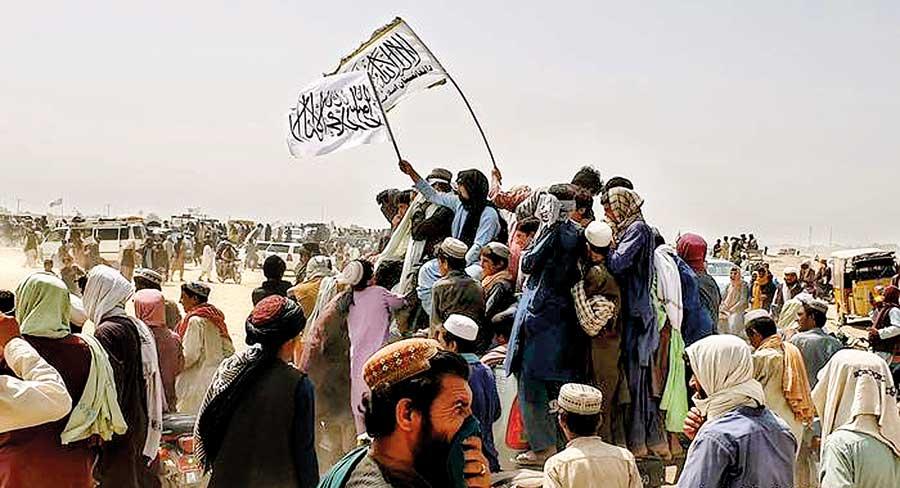Reply To:
Name - Reply Comment

Members of the Taliban group celebrate after gaining power in Afghanistan after US withdrawal
The message has been repeating on a loop. It took 20 years, four US Presidents, some three trillion dollars and 100,000 lives lost (including 72 journalists) to change the Taliban with the Taliban. In 2001, when the cycle started, I was in New York, less than a month after the September 11 attacks. I spent
 hours talking with journalists, editors, a few academics, and lots of ordinary Americans. Their anger and fear were palpable. In some cases, so was the sense of their supremacy being damaged, the fortress had been penetrated. Retribution was very much in the air.
hours talking with journalists, editors, a few academics, and lots of ordinary Americans. Their anger and fear were palpable. In some cases, so was the sense of their supremacy being damaged, the fortress had been penetrated. Retribution was very much in the air.
But no one ever had any inclinations that two decades later, the US would exit Afghanistan after failing miserably in its nation-building efforts not only there but also in Iraq. When the US and allied forces entered Afghanistan, so did legions of journalists. Then it was an unknown frontier, a land of mayhem and mystery. There was only one known image of the leader of the Taliban, Mullah Omar then. That was how reclusive Afghanistan was.
In 2002, only 0.01% of the Afghan population used the net, according to Brookings Institute data. There were only 33,000 fixed line phones and 25,000 mobile connections. Two decades on the situation has changed.
"In 2002, only 0.01% of the Afghan population used the net, according to Brookings Institute data. There were only 33,000 fixed line phones and 25,000 mobile connections. Two decades on the situation has changed"
Above 15% of the population now uses the internet. Three years ago, there were 21 million mobile subscriptions. In 2003, there were only 7,200 women in universities, by 2019 that figured had risen to 49,000.
In 2001, the only images we got from Afghanistan were from the journalists and military that was there. Last week, it was ordinary citizens who were putting up images and details of what was happening. The militant factions use social media as part of their first form of PR.
I am by no means an expert on Afghanistan. But I do have friends who are still there, some of whom who have tried desperately to move to safer locations in the last two weeks. Like with Myanmar in February, my work and my personal networks have meant that I have been in contact with these journalists.
Their messages of desperation echo those I heard from Myanmar. There too not so long ago I witnessed how these journalists watched in horror as their international colleagues and experts moved out of the country.
Like in Myanmar, in Afghanistan also China’s role will be pivotal now. In the two decades since 2001, the Chinese economy has grown at least 17-fold. Beijing along with Islamabad and Moscow will stand to gain the most from the US exit, at least in terms of influence.
But at least, unlike in the 2001, we have access to the country and can see beyond the rhetoric of the victor and the vanquished.
"Like in Myanmar, in Afghanistan also China’s role will be pivotal now. In the two decades since 2001, the Chinese economy has grown at least 17-fold. Beijing along with Islamabad and Moscow will stand to gain the most from the US exit, at least in terms of influence"
“If wars are fought through innovation, the Taliban won,” the MITTech Review said this week, adding, “but the real technological advance for the Taliban took place at the strategic level. Acutely aware of their past shortcomings, they have attempted to overcome the weaknesses of their previous stint in government. Since then, though, the Taliban have developed a sophisticated public affairs team, harnessing social media domestically and abroad. IED attacks would usually be recorded by mobile phone and uploaded to one of the many Taliban Twitter feeds to help with recruitment, fundraising, and morale. Another example is the technique of automatically scraping social media for key phrases like “ISI support”—referring to Pakistan’s security service, which has a relationship with the Taliban—and then unleashing an army of online bots to send messages that attempt to refashion the image of the movement.”
Another phrase that is on a repeat loop these days is Taliban telling the US and allies, that they had time on their hand while the others had the watch. If time is anything, Taliban can hold out till new-found international attention wanes, like what the Myanmar junta did and then unleash the fangs.
The writer is a journalism researcher and a writer.
He can be contacted on
[email protected]